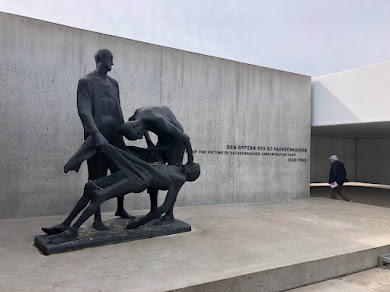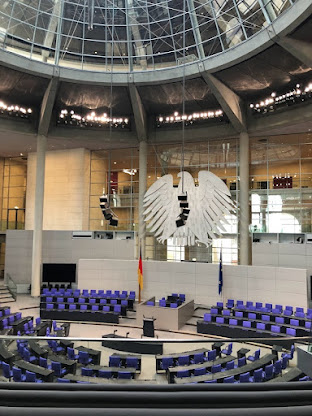Blocker Blog - Entry 5: Sachenhausen
I have been focusing on how Germany, especially Berlin, has started to acknowledge its deeper past before the 20th century. What took me to focus on Germany’s acknowledgment of its actions during the 20th century, particularly during the Nazi era and WWII, was our trip to Sachsenhausen, a former concentration camp turned museum and memorial. In this place being just on the outskirts of Berlin, it made me realize how close I was from one of the many places where so much violence happened. The way to get there only consists of taking the S1 to Orarienburg and then taking a 15 minute walk from the station. The scenery around the place is green, like many places around Berlin. However our tour guides would drill into our heads that that would not be the way that many people would feel during the Nazi regime.
Though initially small, the work camp would eventually have 3 times more people that it was initially designed for. Although not a death camp, since those were built in what is today Poland (such as the famous Auschwitz), many people still face death. The parameters consisted of a tall brick wall and an electric fence. When entering the camp, the only gate available has the phrase “Arbeit Macht Frei” , meaning something like ‘work will set you free’. In retrospect that phrase feels ironic at best and cynical at worst. Once inside, we continued with our tour, where we were told the living conditions in the camp, as well as the events that took place during Hitlers reign and after the war. Though most of the buildings that were once there are now marked by metal frames on the ground, it could not help but feel a sense of difficulty breathing. The more we were told about how helpless the victims were and how it was virtually impossible to escape, the more helpless I myself became about the damage done to generations of people. Other than being told the facts, we were reassured about how one is not supposed to be feeling any sort of ease or ,goodness-forbid, happiness about the place. People here died in horrible ways, whether from exhaustion or hunger, from hypothermia or a bullet to the head, or even from breathing in toxic gasses. I will spare the graphic details from the instances that we were told of but the point of all of this was to heavily remind people what could happened at the hands of right-down evil leaders, leaders who are willing to cope the panic of a fractured nation just to achieve absolute power at the cost of millions of lives. Places like Sachsenhausen make history feel very much real and not just something from another world, it makes the past more understandable to imagine and relive.
When comparing places such as former concentration camps in Germany and central Europe to museums and memorials in the United States, the effect is not the same as remembering the dark chapters of history or it is not even there at all. For the US, something as heavy as the topic of slavery should have tangential places like Sachenhausen, where it could show the public about the life-conditions of an enslaved person and the atmosphere around the experience of being enslaved. Although I must recognize that Germany has specific regional places were mass murders took place in a way that the US does not, institutions should still have places where dehumanization happened; Southern plantations and slave ports come to mind. This is only one of the many dark chapters in US history and it is a topic that I could spend hours thinking about, but in going to Sachenhausen, it has
made me appreciate how Germany is heavily aware of its past and it is willing to have difficult conversations about it, without mincing words.







Comments
Post a Comment